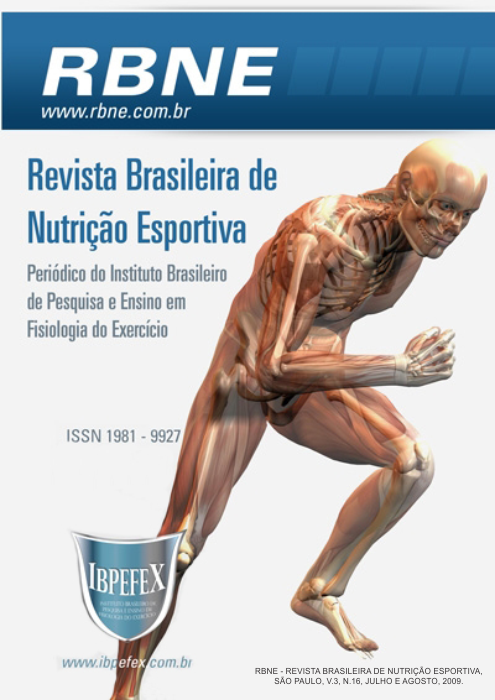Sharp answer of the blood pressure, heart frequency and of the double-product in the exercise resisted after hydration
Abstract
Now, a number every time larger of concerned individuals is seen with the improvement of his/her aesthetics, physical fitness, of his/her general state of health, to conquer a better life quality. Though, they are scarce the information about such behavior as for the hydration types, before and during resistance training, what requests analyses research. The type of ingested liquid should be considered in situations of resistance training, in matter for subjects that need special cares with respect to the cardiovascular answers during the exercise. The values obtained in the results of the sample, he/she makes to verify us that there was not significant difference in the moment of rest of FCrep, PASrep and DPrep in the hydration states. In all of the series, the results show that there were significant increases in the values of FCex1ªs, PASex1ªs, DPex1ªs, FCex2ªs, PASex2ªs, DPex2ªs, FCex3ªs, PASex3ª and DPex3ª with the hydration of the products Gatorade® and Coca-cola®. Having exalts significance p=<0.001 between the hydrations of mineral water and hydration with Gatorade®. We can observe, when there is a hydration with mineral water obtained smaller results, compared with the results of the other hydration states. In FCrec1min, PASrec1min, DPrec1min, FCrec 2min, DPrec2min, FCrec5min, DPrec5min also indicate us, that the hydration with mineral water in the group to a faster and efficient recovery, in comparison with the other hydration states. And that the hydration of Gatorade® and Coca-cola®, they suggest us a slower recovery, of the variables hemodynamic of the study.
References
- American College of Sports Medicine. Position stand: Progression models in resistance training for healthy adults. Med. Sci Sports Exerc. Vol. 34. 2002. p. 364-380.
- Coleman, E. Aspectos Atuais Sobre Bebidas para Esportitas. 1996. GSSI. Num. 03. janeiro/fevereiro 1996.
- Lamb, D.R.; Shehata, A.H. Benefícios e limitações da pré-hidratação. GSSI. Num. 24. out./nov./dezembro 1999.
- Maughan, R.J. Reidratação e recuperação após o exercício. GSSI. Num. 12.1997.
- Mcardle, W.D.; Katch, F.I.; Katch. V.L. Fisiologia do exercício 5a edição Guanabara Koogan, 2003.
- Murray, B. Reposição de Fluídos - posição do Colégio americano de Medicina do Esporte. GSSI. Num. 13. setembro/outubro 1997.
- Nose, H.; Mack, G.W.; Shi, X.; Nadel,ER. Role of osmolality and plasma volume during Rehydration in Humans. J. Appl. Physiol. Num. 65. 1988. p. 325-331.
- Monteiro, M.F.; Sobral Filho, D.C. Exercício Físico e o controle da pressão arterial. Rev. Bras Med. Esporte. Vol. 10. Num. 6. Nov./Dez, 2004. p. 513-516.
- Polito, M.D.; Farinatti, R,T,V, Considerações sobre a meida da pressão arterial em exercícios contra-resistência. Rev. Bras Med. Esporte. Vol. 9. 2003. p. 25-33.
- Polito, M.D.; Farinatti, P.T.VFDuplo-produto ao Exercício Contra-resistência: uma revisão de literatura. Rev. Portug. Cienc. Desport. Rio de Janeiro. Vol. 3. Num. 1. 2003a. p.79-91.
- Polito, M.D.; FFarinatti. P.T.V. Resposta da Frequência Cardíaca, Pressão Arterial e Duplo-produto em Séries Sucessivas do Exercício de Força com Diferentes Intervalos de Recuperação. Rev. Portuguesa de Ciências do Desporto. Vol. 4. Num. 3. 2004. p. 7-15.
- Pollock, M.L.; Wilmore, J.H. Exercício na saúde e na doença. 2a edição. Medsi. 1993
- Santos, B.M.R.S.; e colaboradores. Influence of physical exercise and sodium intake on arterial pressure and cardiac hypertrophy in rats. Rev. Hosp. Clín. Fac. Med. São Paulo. Vol. 54. Num. 4. 1999. p. 111-114.
- Fleck, J.S.; Kraemer, W.J. Fundamentos de treinamento de força muscular. 1996.
- Thompson, P.D. Exercício e a cardiologia do esporte. Manole. 2004.
- Weineck, J. Biologia do esporte. Manole. 1991.
- Wilmore. J.H.; Costill, D.L. Fisiologia do esporte e do exercício. 2a. ed. São Paulo. Manole, 2003.
Authors who publish in this journal agree to the following terms:
- Authors retain the copyright and grant the journal the right of first publication, with work simultaneously licensed under the Creative Commons Attribution License BY-NC which allows the sharing of the work with acknowledgment of the authorship of the work and initial publication in this journal.
- Authors are authorized to enter into additional contracts separately for non-exclusive distribution of the version of the work published in this journal (eg, publishing in institutional repository or book chapter), with acknowledgment of authorship and initial publication in this journal.
- Authors are allowed and encouraged to post and distribute their work online (eg, in institutional repositories or on their personal page) at any point before or during the editorial process, as this can bring about productive change as well as increase impact and impact. citation of published work (See The Effect of Free Access).






